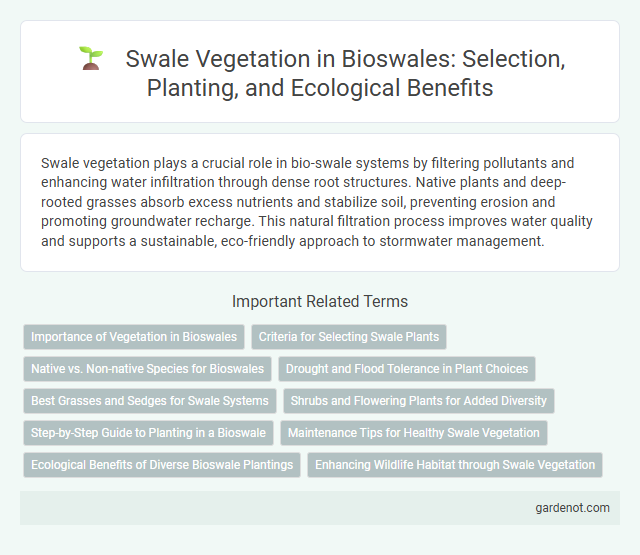Swale vegetation plays a crucial role in bio-swale systems by filtering pollutants and enhancing water infiltration through dense root structures. Native plants and deep-rooted grasses absorb excess nutrients and stabilize soil, preventing erosion and promoting groundwater recharge. This natural filtration process improves water quality and supports a sustainable, eco-friendly approach to stormwater management.
Importance of Vegetation in Bioswales
Vegetation in bioswales plays a critical role in enhancing stormwater filtration by trapping sediments, nutrients, and pollutants from runoff, thereby improving water quality. Deep-rooted native plants stabilize soil, reduce erosion, and promote infiltration rates, which assists in groundwater recharge. The diverse plant species also support habitat for local wildlife and contribute to urban biodiversity, reinforcing ecosystem resilience.
Criteria for Selecting Swale Plants
Swale vegetation selection prioritizes native, deep-rooted plants that enhance water infiltration and support soil stabilization through extensive root systems. Plants must tolerate periodic flooding, variable moisture levels, and provide pollutant filtration by absorbing nutrients and heavy metals. Optimal swale plants include grasses, sedges, and hardy perennials that promote biodiversity and require minimal maintenance in urban stormwater management.
Native vs. Non-native Species for Bioswales
Swale vegetation in bioswales predominantly includes native species such as Juncus effusus and Carex obnupta, which enhance water filtration and support local biodiversity. Non-native species may establish quickly but often lack the ecological benefits of native plants, sometimes leading to reduced infiltration and habitat value. Prioritizing native vegetation improves stormwater management efficiency and promotes sustainable ecosystem health.
Drought and Flood Tolerance in Plant Choices
Swale vegetation plays a crucial role in managing stormwater by incorporating plants with high drought and flood tolerance, ensuring resilience in fluctuating moisture conditions. Native grasses such as switchgrass and sedges can survive prolonged dry periods while also withstanding temporary inundation during heavy rains. Selecting species like willow and bulrush enhances the bio-swale's efficiency in water absorption and filtration, promoting sustainable urban water management.
Best Grasses and Sedges for Swale Systems
Optimal vegetation for bio-swale systems includes native grasses and sedges such as Carex stricta (tussock sedge), Juncus effusus (soft rush), and Bouteloua curtipendula (sideoats grama) for their deep root structures that enhance soil stability and water infiltration. These species tolerate fluctuating moisture levels and improve pollutant filtration by trapping sediments and heavy metals within swale catchments. Incorporating a diverse mix of drought-tolerant and wet-tolerant plants maximizes swale functionality and supports sustainable stormwater management.
Shrubs and Flowering Plants for Added Diversity
Swale vegetation plays a crucial role in bio-swales by incorporating shrubs and flowering plants that enhance biodiversity and improve pollutant filtration. Native shrubs such as dogwood and buttonbush provide structural habitat, while flowering plants like black-eyed Susan and milkweed support pollinators and increase aesthetic appeal. Integrating diverse plant species ensures resilience against erosion, promotes water infiltration, and optimizes the ecological function of bio-swales.
Step-by-Step Guide to Planting in a Bioswale
Selecting native, drought-tolerant plants such as sedges, rushes, and wetland wildflowers enhances water absorption and pollutant filtration in a bioswale. Begin by preparing the soil with organic compost to improve nutrient content and ensure proper grading for optimal water flow. Plant vegetation in clusters according to moisture tolerance zones, spacing them to allow root expansion and facilitate maintenance.
Maintenance Tips for Healthy Swale Vegetation
Maintaining healthy swale vegetation requires regular inspection to remove invasive species, ensuring native plants receive adequate sunlight and nutrients. Proper irrigation practices help prevent waterlogging and drought stress, promoting robust root development in swale plants. Seasonal pruning and mulching enhance soil health and maximize vegetation growth for effective stormwater filtration.
Ecological Benefits of Diverse Bioswale Plantings
Diverse bioswale plantings enhance habitat complexity, supporting pollinators and beneficial insects critical for ecosystem health. They improve stormwater filtration by utilizing various root structures that increase soil permeability and nutrient uptake. This biodiversity also stabilizes soil, reduces erosion, and promotes resilience against environmental stressors in urban landscapes.
Enhancing Wildlife Habitat through Swale Vegetation
Swale vegetation plays a crucial role in enhancing wildlife habitat by providing native plants that offer food, shelter, and breeding grounds for various species. Diverse plantings of grasses, shrubs, and flowering plants support pollinators such as bees and butterflies while also attracting birds and small mammals. The strategic selection of native vegetation in bio-swales improves ecological connectivity and promotes biodiversity within urban and suburban landscapes.
Swale vegetation Infographic

 gardenot.com
gardenot.com